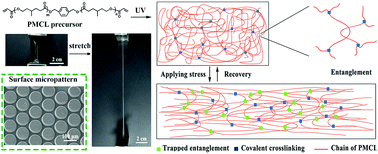A highly stretchable bioelastomer prepared by UV curing of liquid-like poly(4-methyl-ε-caprolactone) precursors†
Abstract
A series of biodegradable and crosslinkable precursors based on poly(4-methyl-ε-caprolactone) (PMCL) were prepared by ring-opening polymerization (ROP), followed by the complete acrylation of both hydroxyl ends. Afterwards, biodegradable networks exhibiting totally amorphous character were obtained via photocrosslinking without organic solvent or high temperature. As a result, their mechanical properties varied significantly from brittle to elastic upon increasing the length of the PMCL precursors. Both covalent crosslinking and trapped entanglements between crosslinking segments were likely to contribute to the unique properties of the bioelastomer. In particular, networks formed by the precursors with large molecular weights presented high flexibility and resilience, which match the mechanical properties of soft tissues like blood vessels, bladder and cardiovascular tissue. Preliminary degradation and in vitro cytotoxicity studies of the crosslinked network showed excellent biodegradability and biocompatibility. Moreover, it was demonstrated that the liquid-like PMCL precursor made the patterning easily processable even in the absence of any solvent or heating.



 Please wait while we load your content...
Please wait while we load your content...